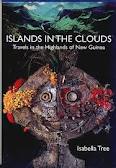1996, 256 p.
I must admit that I’ve never really understood the appeal of the travel-book genre but this was the selection for my face-to-face bookgroup this month. Just as I would entreat my children “Just a little taste…”, so too I had to be nudged into reading this book, but just like broccoli, it wasn’t too bad after all- in fact I quite enjoyed it.
The book itself is a compilation of three different journeys to New Guinea: the first in 1986, the second in 1991 and the epilogue in 1993. The author tries as much as possible to erase herself from the narrative. We do not know why she is there, what her expectations are, and what other experiences she brings to her observations. The fact that she is a young woman traveling alone into remote and partially traditional tribal homelands is largely left unremarked, and the trips she describes are not lengthy at all- each one lasting barely a week.
Her travel companion for much of her journey was Akunia, an Eastern Highlander man, who had had a Western education, courtesy of various aid and diplomatic schemes. Over the years he had been involved in both local politics and development projects, and he provided another lens through which to view the places and events they encountered. However, the author soon realized that Akunia’s expertise was largely limited to his own local region: once they moved the Western highlands, and even further into Irian Jaya, he was almost as much of a stranger as she was. Perhaps even more so, because he knew enough to be apprehensive, and was at various times frightened, racist and dismissive.
In crossing into Irian Jaya (West Papua), they were indeed entering another country, and were not allowed to forget it. All entry was by air only and under heavy border scrutiny. However, once they moved away from the Indonesian-dominated coastal area into the highlands of West Papua, the tribal people were both amazed and delighted to find commonalities in customs and appearance between themselves and Akunai, a rare venturer from the other side of the border. She makes no secret of her uneasiness over the Indonesia domination- and I believe that there is much to be uneasy about.
Her criticisms of the rapaciousness of the mining companies rang even more true for me having witnessed the ruthlessness of the mining lobby here in Australia against a democratically- elected, first-world government. A young democracy, wobbly on its feet, wouldn’t stand a chance. Akunai and the author both share an ambivalence over the inevitability of consumerism and ‘progress’ at all levels: cultural, spiritual, environmental. The violence, it seems, abated under the influence of missionaries, but there too is another conundrum. I found myself reading the newspaper reports about the commencement of their election process this week with more interest than I would have previously.
The book is well-written and very easy to read. It had a good useful map at the start, which would have been even more useful had her journey been marked on it. She integrated pidgin into her chapter headings and within the dialogue of the book, and although she provided a glossary, I found myself able to work it out for myself if I spoke it out loud.
So- this book, published under the the Lonely Planet imprint, was a pleasant surprise really. Not enough, however, to tempt me northwards…
My rating: 7/10
Sourced from: CAE
Read because: it was the June selection for my face-to-face bookgroup

